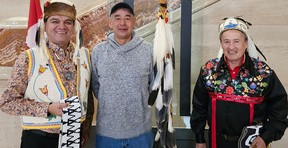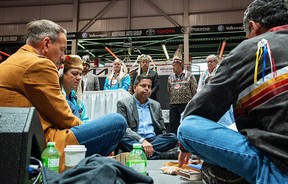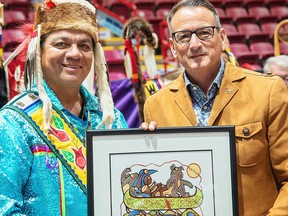What to do with the biggest treaty settlement in Canada’s history remains a thorny issue
Article content
By Peter Kuitenbrouwer
A line of people stretched outside the Multi-Educational Centre at Sagamok Anishnawbek First Nation, once known as the Spanish River Indian Reserve, on the north shore of Lake Huron between Sudbury and Sault Ste. Marie, Ont., on June 29.
Article content
A representative of Indigenous Services Canada handed each person two toonies. The $4 payment dates back to 1850, when the ancestors of Indigenous people who live on Canada’s side of Lake Huron, known as the Anishnawbe, signed a treaty with William Robinson, a former fur trader who represented the Crown for the colony of Upper Canada.
Advertisement 2
Article content
At the time, they agreed to allow logging, mining and settlement in their watershed, with compensation fixed at $1.70 per person in the communities affected. The annual payout increased once — to $4. Since then, resource companies have extracted a great deal of nickel, copper, uranium, lumber and fish from the region and thousands of settlers have moved in. But the payout stayed at $4.
Sick of tokenism, 21 First Nations, descendants of the signatories of the 1850 deal, sued in 2012. After several court victories, these First Nations are now in line for a bigger payout. Under an out-of-court deal negotiated last summer, Ottawa and Ontario have agreed to hand over $10 billion. The money, set to flow early in the new year, is the biggest treaty settlement in Canada’s history.

Understandably, there is excitement in the communities that stand to benefit, but also rumours and tension. Some members want a cheque, also known as per capital distribution (PCD): about $286,000 for each of the roughly 35,000 Indigenous people. But many local leaders believe a smarter path would be to invest the proceeds for the long-term benefit of the community and its future generations.
Advertisement 3
Article content
‘Everybody and their brother is talking to them’
The job to advise these First Nations communities on how to handle this tsunami of cash has become a kind of cottage industry of its own. Lawyers, bankers, and trust companies each want to get the business, for which they could earn up to a quarter of one per cent of the total settlement amount.
“Everybody and their brother is talking to them,” said Jack Jamieson, vice-president at T.E. Wealth Indigenous Services, a division of Canadian Western Bank that provides financial advice to more than 50 First Nations. “We are meeting with many leaders, with a mission to help meet the needs of today and build for future generations.”
It’s easy to see why many Indigenous people might prefer an immediate cash payout. At Sagamok on that day last summer, the lineup stretched to 100 people. One community member set up a lemonade stand near the head of the line.
“The lemonade guy charges $4 for lemonade,” Angus Toulouse, Sagamok’s Chief, recalled. “So, there is the treaty payment gone in a drink of lemonade. What we are getting on our end is the $4, and yet the land, the waters, the trees, are enjoyed by all Ontarians and all Canadians.”
Article content
Advertisement 4
Article content
Worst of all, he said, government representatives ran out of toonies that day.
“The reality is that there are some people with high expectations that the whole amount should be distributed to the living annuitants, beneficiaries,” said Duke Peltier, a trustee of the Robinson Huron Treaty Litigation Fund. “But it’s too simplistic of a view because, for one, they are not 150 years old, so they shouldn’t think that they are entitled to that whole amount.”
Payout vs trust
A one-time handover may also not be good for those it intends to benefit. Other First Nations communities have seen what happens when a big sudden influx of cash is paid out to each band member.
“We worked with (First) Nations where they decided to do a PCD,” one person with knowledge of these matters said. “There was a huge spike in alcoholism and drug addiction. The community goes through hell for a short period of time and then the money is gone.”
In some cases, community members have sued the chief and council over such deals, essentially saying “you didn’t fulfil your duty to the long-term benefit of the community.”
Advertisement 5
Article content
In other cases, a bank has negotiated a deal with a First Nation to set up a trust, but then the band holds an election, and a new slate of councillors wins on a campaign pledge to dole out settlement cash on a per-capita basis.
Jamieson is aware of the pitfalls of handing out large sums of cash in the form of a PCD.
“It can be very positive for members, but create significant challenges that can have negative impacts on other individuals,” he said.
Setting up a trust, by contrast, takes a lot of foresight. His practice first works with the community to create a vision, then helps them find a lawyer to write a trust agreement. The next step is to find corporate and member trustees. Then the trust needs investment policies, a manager and, finally, performance monitoring.
“There has to be a lot of financial wellness education to help show them the potential,” Jamieson said.
Amid those banks vying to sell their financial services to First Nations, Bank of Montreal has made some inroads. The bank owes its success in part to its previous work with the communities. That relationship dates to at least 2012, the year the 21 First Nations created the Robinson Huron Treaty Litigation Fund to pursue a legal claim.
Advertisement 6
Article content
“Legal invoices started coming in,” Peltier said. “We quickly realized that we are not going to have enough money to keep momentum on this case. We met with different financiers, and a group in Toronto introduced us to some of the executives at Bank of Montreal. The bank was serious about supporting us. Once we won stage one, we needed some money again, and they were the ones who came knocking at our door to say, ‘We are prepared to provide another line of credit for you to ensure that the case continues.’”
That relationship has now borne fruit, with Sagamok hiring the bank to establish a trust fund for future generations.
“In our community in Sagamok, our council has made a decision to go with the Bank of Montreal,” Toulouse said. “We did review other proposals from other institutions that were willing to work with us in developing our own Sagamok Trust, but we chose the Bank of Montreal. They offered good rates. The fees were manageable, reasonable, and they offered the service that we are looking for in terms of the trustee.”
Bank of Montreal said in an email it “wouldn’t comment on a client.”
Advertisement 7
Article content
Nevertheless, leaders of the 21 communities covered by the Robinson Huron Treaty face long-standing challenges managing expectations for the settlement money. In places such as Manitoulin, the world’s largest freshwater island, which lies in Georgian Bay and is home to five First Nations communities, frustration over the meagre annuity payments from the 1850 deal has been building for a long time.
Canada’s Indian Affairs Central Registry Files holds a record entitled: Manitoulin Island Agency – Correspondence Regarding Land Sales in Howland Township that Was Being Used as a Sugarbush by the Indians. In 1875, the Indian agent, as that job was then known, for Manitoulin wrote a letter to Ottawa, longhand with a quill pen, recounting a “Council of Indians” held on Feb. 24 of that year.
“Chief Taibosegar … also enquired whether I had ever received any communications in reference to the petition presented by the Indians to His Excellency the Governor General at Little Current last summer, asking for an increase in their annuity under the Robinson Treaty,” the agent wrote.
Advertisement 8
Article content
The reply from Ottawa included this passage: “You will be good enough to inform the council that the subject of the claim of the Indians of Lake Huron and Superior to an increase of annuity is receiving the consideration of the government.”
True to its word, Ottawa in 1875 raised the annuity to $4. It never budged again.

The largest Indigenous community on Manitoulin is Wikwemikong, known to locals as Wiikwemkoong Unceded Territory. Peltier, the Robinson Huron Litigation trustee, hails from Wiikwemkoong. He sees the impending annuity settlement as a game-changer.
Game-changer
“The very essence of a nation is that they have resources to sustain their citizens, they have citizens, they have their own language, they have their own land base,” he said. “We don’t have a lot of land, but we have some land, we have our people, we have our language, our customs, our culture, and the thing that’s missing is the actual resources.”
The needs are great. Peltier last summer embarked on a tour of all 21 communities to talk to them about the settlement offer. In one village, locals gathered in a recreation centre on a rainy day to speak to him. Rain poured in through holes in the roof; the band has no money for a new roof.
Advertisement 9
Article content
“That is one very specific example that these funds from this settlement could address in fairly short order, for that community to be able to assemble together and have those community feasts and baby-welcoming ceremonies and also send our loved ones home back to the creator,” Peltier said.
Adds Toulouse: “A lot of communities are looking at housing. Basic infrastructure. In our community we have many children playing, but we don’t have any sidewalks, and they are walking on the edge of the road. We need to have the kind of infrastructure that you see in any community. School. Recreation facility. Those kinds of things. The retail outlets. Restaurants. We go to town for all of that.”

Plans to invest settlement money in community facilities, however, slam up against a fundamental issue: many band members live off reserve.
“Those people could say, ‘What are you going to do for me, chief?’” said Jamieson, whose company has helped Indigenous communities with financial literacy since 1997. “The member might say, ‘Gee, I might prefer a per-capita distribution because I am living off reserve.’ That is always the biggest tug of war on settlement money.”
Advertisement 10
Article content
Meanwhile, First Nations are becoming more savvy on investing settlement proceeds, with help from such groups as the National Aboriginal Trust Office Association. A trustee training program at Lethbridge College in Alberta empowers trustees to make good decisions.
“It is a long way from where it was 20 years ago,” Jamieson said. “People are making more informed and educated decisions.” He added that leadership at First Nations across the country, “is very engaged in setting up systems so they are wealth-creation entities, to grow the wealth and not rely on governments, going forward.”
Even so, at least some of the money will go out as PCDs. The communities are aware of the pluses and minuses of this influx of cash, Peltier said.
“We need to make preparations now on how to educate our community members on how to manage a larger lump sum amount of money, and so they are looking at financial literacy training,” he said. “They are creating additional capacity for personal support workers, they are also looking at increasing the addiction and recovery type services, so the staff and the community leaders are all very much aware of the impacts of larger sums of money and even the police are aware. They are very much in that conversation also on how to strategize and support the community and its members when funds do ultimately get dispersed.”
Advertisement 11
Article content
Related Stories
In early November, Toulouse and Peltier sat in the Supreme Court of Canada as the Province of Ontario appealed court rulings in the treaty case to limit its obligations regarding future annuity payments. This summer’s settlement does not resolve what annuity amount the communities will get next year. For now, that payment remains at $4, a spokesperson at Indigenous Services Canada said in response to a question. Enough for a lemonade … as long as the price doesn’t rise.
Bookmark our website and support our journalism: Don’t miss the business news you need to know — add financialpost.com to your bookmarks and sign up for our newsletters here.
Article content
Ontario First Nations get $10-billion windfall
2023-11-17 14:01:45






Comments
Postmedia is committed to maintaining a lively but civil forum for discussion and encourage all readers to share their views on our articles. Comments may take up to an hour for moderation before appearing on the site. We ask you to keep your comments relevant and respectful. We have enabled email notifications—you will now receive an email if you receive a reply to your comment, there is an update to a comment thread you follow or if a user you follow comments. Visit our Community Guidelines for more information and details on how to adjust your email settings.